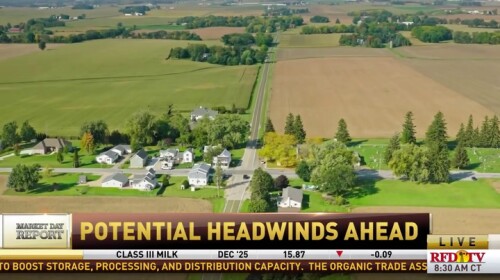Agricultural Studies & Research
Strong Farm Credit finances help cushion producers, but prolonged low crop margins could strain renewals in 2026.
Cattle imports from Mexico remain stalled amid the New World screwworm outbreak. At the same time, Tyson closures add pressure on Nebraska producers and markets ahead of the USDA’s upcoming Cattle on Feed Report.
Southern producers head into 2026 with thin margins, tighter credit, and rising agronomic risks despite scattered yield improvements.
Record yields and exceptionally low BCFM strengthen U.S. corn’s competitive position in global markets.
Water access—not acreage alone—is driving where irrigation expands or contracts.
Mike Steenhoek, with the Soy Transportation Commission, shares his outlook on current grain stocks and transportation lines amid bumper crops filling bins across the United States.
The FAO Food Price Index for November fell by more than 1 percent in November, marking the third straight month of declines.
Buying a real Christmas tree directly supports U.S. farmers facing rising import competition, long production cycles, and weather-driven risks.
Milk output is rising, but steep drops in Class I–IV prices are tightening margins heading into 2026.
Tight cattle supplies continue to drive lower beef output despite heavier weights.
Weaker U.S. dairy prices come as value-added exports expand and ingredient inventories tighten, creating mixed market signals for producers.
Improved export prospects and higher crop prices strengthened future expectations despite continued caution about spending.
While the agriculture industry hoped details on proposed “bridge” payments for farmers would be released this week, Ag Secretary Brook Rollins said the USDA is still working with the White House on the finer points.
Strong demand supports sweet potatoes, but grading challenges and rising costs weigh on returns for Southeastern growers.
Pressure on grain storage capacity and stronger export positioning are pushing more grain onto railroads, highways, and river systems as logistics become a key bottleneck this fall.
The Cotton-4 are pushing hard for new value chain investments. Still, many U.S. cotton producers face unsustainable losses, and weakened regional textile capacity threatens the survival of the Carolina “dirt-to-shirt” supply chain.
Late harvest and tight supplies shape crop progress and agribusiness this week. Here is a regional snapshot of harvest pace, crop conditions, logistics, and livestock economics across U.S. agriculture for the week of Dec. 1, 2025.
Tryston Beyrer, Crop Nutrition Lead at The Mosaic Company, examines planning trends as producers weigh corn and soybean plantings for 2026.
Brooks York with AgriSompo joins us to offer an update on what agents are prioritizing as the calendar year winds down.
The newly elected Executive Vice President of the Tennessee Cattlemen’s Association (TCA), Dale Parker, joins us on-set to share his vision for his state’s cattle industry.
SDRP Stage 2 now helps producers recover shallow, uninsured losses from major 2023–2024 disasters, with streamlined sign-ups open through April 30.
























